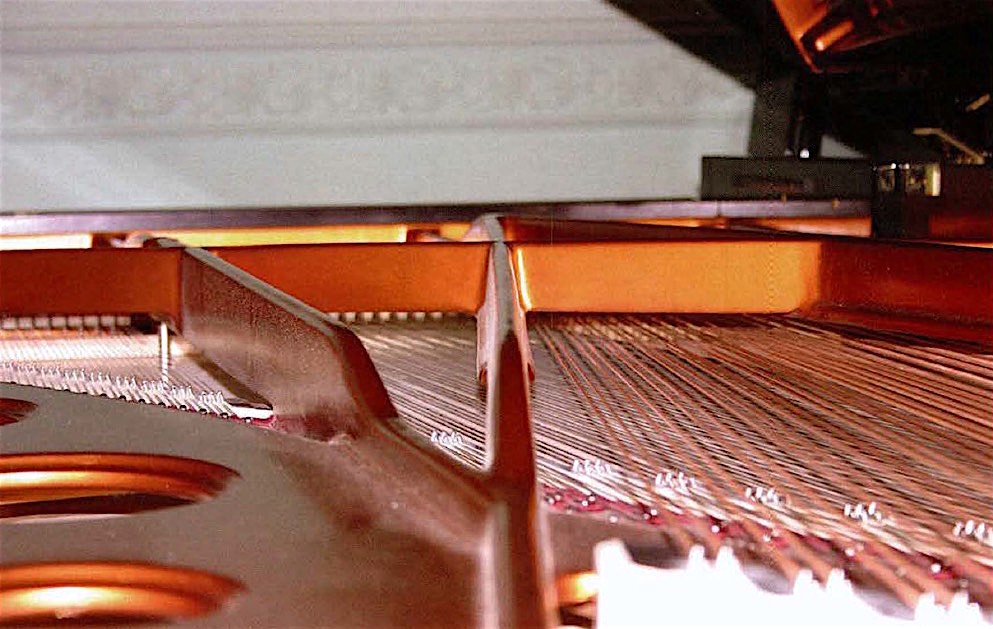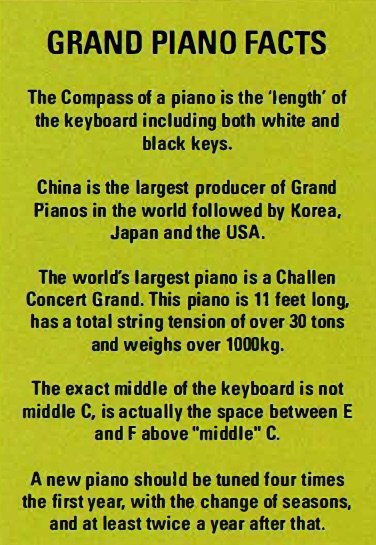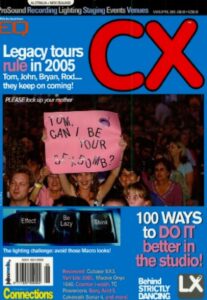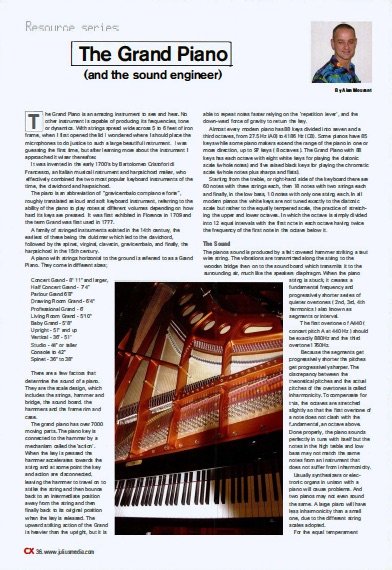News
11 Apr 2019
The Grand Piano (and the sound engineer)
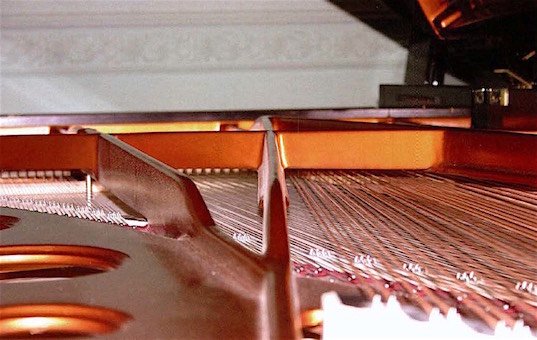
Subscribe to CX E-News
Resource Series
 The Grand Piano (and the sound engineer)
The Grand Piano (and the sound engineer)
by Alan Mourant.
Originally published in CX13 – March/April 2005.
The Grand Piano is an amazing instrument to see and hear. No other instrument is capable of producing its frequencies, tone or dynamics. With strings spread wide across 5 to 6 feet of iron frame, when I first opened the lid I wondered where I should place the microphones to do justice to such a large beautiful instrument. I was guessing the first time, but after learning more about the instrument I approached it wiser thereafter.
It was invented in the early 1700’s by Bartolomeo Cristofori di Francesco, an Italian musical instrument and harpsichord maker, who effectively combined the two most popular keyboard instruments of the time, the clavichord and harpsichord.
The piano is an abbreviation of “gravicembalo col piano e forte” roughly translated as loud and soft keyboard instrument, referring to the ability of the piano to play notes at different volumes depending on how hard its keys are pressed. It was first exhibited in Florence in 1709 and the term Grand was first used in 1777.
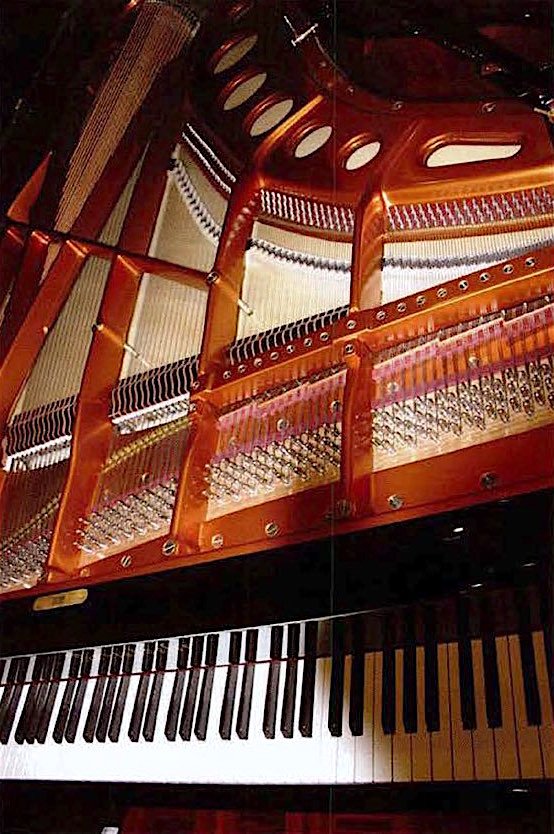 A family of stringed instruments existed in the 14th century the earliest of these being the dulcimer which led to the clavichord. followed by the spinet, virginal, clavecin, gravicembalo and finally, the harpsichord in the 15th century.
A family of stringed instruments existed in the 14th century the earliest of these being the dulcimer which led to the clavichord. followed by the spinet, virginal, clavecin, gravicembalo and finally, the harpsichord in the 15th century.
A piano with strings horizontal to the ground is referred to as a Grand Piano. They come in different sizes:
Concert Grand – 8′ 11′ and larger
Half Concert Grand – 7’4′
Parlour Grand 6’8′
Drawing Room Grand – 6’4″
Professional Grand – 6′
Living Room Grand – 5′ 10
Baby Grand – 5 ‘8″
Upright – 51′ and up
Vertical – 36′ – 51
Studio – 44′ or taller
Console to 42′
Spinet – 36′ to 38’
There are a few factors that determine the sound of a piano. They are the scale design, which includes the strings, hammer and bridge, the sound board. the hammers and the frame rim and case.
The grand piano has over 7000 moving parts. The piano key is connected to the hammer by a mechanism called the ‘action’. When the key is pressed the hammer accelerates towards the string and at some point the key and action are disconnected, leaving the hammer to travel on to strike the string and then bounce back to an intermediate position away from the string and then finally back to its original position when the key is released.
The upward striking action of the Grand is heavier than the upright, but it is able to repeat notes faster relying on the ‘repetition lever’, and the down-ward force of gravity to return the key.
Almost every modern piano has 88 keys divided into seven and a third octaves, from 27 .5 Hz (AO) to 4186 Hz (CS). Some pianos have 85 keys while some piano makers extend the range of the piano in one or more direction, up to 97 keys ( 8 octaves ). The Grand Piano with 88 keys has each octave with eight white keys for playing the diatonic scale (whole notes) and five raised black keys for playing the chromatic scale (whole notes plus sharps and flats).
Starting from the treble, or right-hand side of the keyboard there are 60 notes with three strings each, then 18 notes with two strings each and finally, in the low bass. 10 notes with only one string each. In all modern pianos the white keys are not tuned exactly to the diatonic scale but rather to the equally tempered scale.
The practice of stretching the upper and lower octaves in which the octave is simply divided into 12 equal intervals with the first note in each octave having twice the frequency of the first note in the octave below it.
The Sound
The pianos sound is produced by a felt covered hammer striking a taut wire string. The vibrations are transmitted along the string to the wooden bridge then on to the sound board which transmits it to the surrounding air. much like the speakers diaphragm. When the piano string is struck, it creates a fundamental frequency and progressively shorter series of quieter overtones ( 2nd, 3rd, 4th harmonics) also known as segments or interval.
The first overtone of A440 (concert pitch A at 440 Hz) should be exactly 880Hz and the third overtone 1760Hz. Because the segments get progressively shorter the pitches get progressively sharper. The discrepancy between the theoretical pitches and the actual pitches of the overtones is called inharmonicity. To compensate for this, the octaves are stretched slightly so that the first overtone of a note does not clash with the fundamental, an octave above.
Done properly, the piano sounds perfectly in tune with itself but the notes in the high treble and low bass may not match the same notes from an instrument that does not suffer from inharmonicity.
Usually synthesizers or electronic organs in unison with a piano will cause problems. And two pianos may not even sound the same. A large piano will have less inharmonicity than a small one, due to the different string scales adopted.
For the equal temperament scale, the frequency of each note in the chromatic scale is related to the frequency of the notes next to it by a factor of 1.059463 ( or the twelfth root of 2 )
The twelfth root of two, when multiplied by the frequency of a note, gives the frequency of the next note up. After doing this for twelve notes, you end up with twice the frequency, or one octave up from the starting note and in twelve equal intervals.
In equal temperament, A-flat and G-sharp are the same black key on the piano. This means that a composition written in one key can be shifted up any number of half steps (transposed) and will still contain exactly the same harmony, although the frequencies themselves will be different.
The Just or “harmonic” scale” however has each note related to the fundamental frequency by rational numbers with the semi-tones not equally spaced. Unfortunately this tuning depends heavily on the scale you are using and it is not possible to transpose from one key to another and produce the same harmony. This tuning is common for ensemble choral and orchestral groups who match pitch by ear.
Both ends of the ‘speaking length’ ( length of the string allowed to vibrate ) are fixed (by the bridge at one end, and the agraffe or capo d’astro bar at the other). Each time the hammer strikes the string, the string vibrates outwards along the string towards the bridge at one end and the agraffe at the other end. Each time they arrive at the bridge the sound energy is transferred to the soundboard. The vibration travels the back and forth in a sustain of the note until it ceases. The shorter a string is, relative to thickness, the stiffer it is and the faster it vibrates.
Voicing is a term used to describe the adjustment that involves the hardening or softening of the hammer felt and is performed so that the tone of each note is uniform throughout. Voicing is generally done every few years to revitalize worn felts.
The Construction
The piano has an inner and outer rim, made of multiple layers of solid wood formed by clamping straight thin lengths of these woods around counter moulds.
Glue is applied between the layers to secure them and create the molded shape. The soundboard is glued to the inner rim before attaching the outer a wooden frame is created to provide the maximum strength possible for all the wooden components. A cast iron frame, usually gold plated and very heavy and fixed to the frame, takes the tension of the strings. The over two hundred strings in a piano are stretched across this frame.
The string is attached to a “hitch pin” at one end and wound around the pins on the “pin block” or “wrest plate” which is fitted to the iron frame. This is a multi-layered hardwood that the tuning pins are driven into. accommodating the tuning pins and allows the pins to be turned for tuning. The pins are under enormous pressure and the quality of the pin block will determine the tuning stability of the piano. The pin block is fitted behind the name plate and cannot be visually inspected.
The grand piano has over 7000 moving parts. The piano key is connected to the hammer by a mechanism called the ‘action’. When the key is pressed the hammer accelerates towards the string and at some point the key and action are disconnected, leaving the hammer to travel on to strike the string and then bounce back to an intermediate position away from the string and then finally back to its original position when the key is released.
The upward striking action of the Grand is heavier than the upright, but it is able to repeat notes faster relying on the ‘repetition lever’, and the down-ward force of gravity to return the key. A damper rests on the string to prevent it from vibrating and is raised just prior to the hammer striking the string. Only two-thirds of the strings are dampened as the notes from the high-treble area die off quickly but are free to vibrate sympathetically with the upper harmonics from the lower strings.
Pedals
The Una Corda pedal is the left pedal on a Grand Piano and occasionally on an upright piano. This shifts the whole action to one side so that the hammer only strikes two out of three strings. Of course having few strings struck per note makes the notes quieter. Simply a two string unison sounds different to a three string unison.
They are not only quieter but have a distinctly different timbre now that the hammers have moved and are hitting strings with parts of the hammer not normally used being temporarily replaced with softer less used felt. The unstruck string is left to vibrate in sympathy with its neighbour adding a subtle texture to the sound.
The Middle pedal is the sostenuto pedal or sustain pedal. Unlike the damper pedal which lifts all the dampers and holds all the notes. the sostenuto pedal only sustains the notes that are being held when the pedal is pressed. The sustain mechanism catches and holds the dampers that are in the raised position and any notes played after that behave in the usual manner.
The pedal on the far right is the damper pedal. When pressed, the pedal raises all the dampers at once. Any notes played while the pedal is down blend together and ring out naturally or until the pedal is released. Playing a single note with the damper pedal down sounds different to the same note played with the pedal up, because neighbouring strings are free to vibrate sympathetically.
Some grand pianos will also have a fourth pedal that alters the striking distance or the key depth so as to reduce the momentum of the hammers when they strike the strings. It lifts the hammer rail and at the same time lowers the key height.
The String section
In the lower third of the keyboard range, in the bass section. the strings have a steel core with a copper winding. The first several notes have a single string and the rest in the bass section have double string notes. These are usually mounted diagonally and overlap the other strings. Piano builders vary length, density, and diameter of the strings and keep the tension roughly constant at 150-160 pounds. The typical grand has about 240 strings and a total tension of about 20 tons.
The transition from single string bass notes to double string bass notes is not usually a problem. however. on either side of the “break’ ( between the bass and tenor sections) the strings here are not parallel to each other, the hammers between sections are at different angles and the double unison strings typically change to triple unison.
The string lengths, tensions and wire gauges used in a piano is referred to as its ‘scale’. A well designed scale will minimize the transition across the ‘break’. Different pianos use different scales and the number of bass strings vary. Therefore the break will occur at different locations and an astute listener will more than likely pick the transition on a good piano. If the transition is too noticeable it is likely the piano has been poorly prepared.
Live and Recording the Piano
Consider the speed of sound travels at 343 metres per second and the lowest frequency on a Grand Piano is bottom A 27.5 Hz which is a wavelength about 12 metres long in air.
The largest Grand piano in the world is the Challen Grand measuring just over 3 metres long. Predictably the lowest note on the largest Concert Grand will envelope out of the casing even before reaching one full cycle. The 12 metre long 27.5Hz frequency will take only 36 milliseconds to complete a full cycle and is well and truly out of the piano and reflecting back before this happens. Higher frequencies will cycle many times within the piano itself. adding to the tonality and sonic brilliance of the Grand Piano.
Firstly make sure the piano is tuned to A 440 Concert pitch. This should normally be done by a qualified piano tuner and once it has been tuned the piano should not be moved far. Also wide fluctuations in temperature and humidity should be avoided as this will affect the tune.
When recording, choose high quality condenser large diaphragm microphone with a good frequency response capable of the handling the Grand Piano’s dynamic range and extended bass. Decide whether the lid will be open slightly, half way, or taken off. With the lid closed you are limited to certain microphones that will fit in the space available. With the lid half open there is sometimes insufficient height to place a microphone above the bass strings to capture the entire bass string section so you may have to remove the lid completely to get the mice placed above the bass strings.
Taking the lid off does completely messes up the radiation pattern. with a reduction of energy in the horizontal plane and a substantial increase in the vertical plane. On the other hand keeping the lid closed will dull the piano sound because it does not allow the sound to radiate out from the sound board, radiating generally more in the horizontal plane than the vertical plane.
Some of the best classical recordings have been made using an A-B stereo pair placed on the side of the piano. Adjusting the distance to the piano and next to the piano, the amount of ambience and the timbre of the instrument can be tuned. Place the pair mid of the piano about 1 to 2 meters away with the microphones spaced 40 to 60 cm apart and adjust the stereo image so the pianist is to the left.
The height of the stereo boom is at 1.2 m to 1 .5 m above the piano. By pointing the microphones to the open lid of the piano, the sound reflecting on the inner side of the lid will be brightened giving depth to the recording. An incident pair of ambient room microphones can be added.
If the lid has to be closed for separation in a live situation, use one or two PZM microphones fixed to the underside of the lid – one over the bass strings and one over the treble strings. Another option is the C-ducer, a capacitive tape microphone about 20cm long, 4 cm wide and 1 mm thick, that comes with mounting tape and can be fixed to the underside of the lid, under the piano or on top of the soundboard.
In a live sound scenario, isolation from other instruments can be achieved using the sound holes in the iron frame to pick up the soundboard with the lid closed. Some EQ in the upper midrange and higher would be required to add presence.
A single microphone should be placed centrally or if you are using two microphones place one in the second hole from the top and the other in the second or third hole from the bottom – the bottom being closest to the keys as you are looking at the inside of the piano. Point them into the hole and make sure they are clear of the lid and the cables are out of ‘pinch points’.
As you move the microphones closer to the bridge the sound will tend to have less dynamics but will have a brighter, more vibrant, smoother sound. Closer to the hammer action the sound will be percussive with less warmth and sustain.
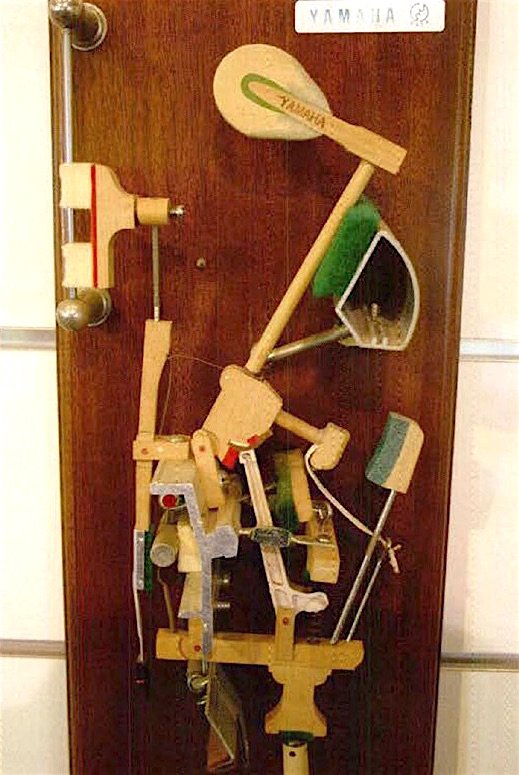 Beware of transients that may clip the microphones or input stage. Somewhere in between the bridge and the hammers is the ‘sweet spot’. Always experiment with microphone placement. Close microphone of the Grand is not recommended because you will likely over-emphasize a small part of the instrument’s notes and a lot of the piano sound will arrive off-axis. The hammer sound, direct radiations, reflections from the lid, soundboard, floor, ceiling, piano rim and room acoustics are all constituent parts of the sound.
Beware of transients that may clip the microphones or input stage. Somewhere in between the bridge and the hammers is the ‘sweet spot’. Always experiment with microphone placement. Close microphone of the Grand is not recommended because you will likely over-emphasize a small part of the instrument’s notes and a lot of the piano sound will arrive off-axis. The hammer sound, direct radiations, reflections from the lid, soundboard, floor, ceiling, piano rim and room acoustics are all constituent parts of the sound.
Place the microphone at least 25cm above the strings and make sure it has a good off-axis frequency response with few if any peaks or dips, so as to capture the total ‘sum of the parts’ – characteristics of the Grand Piano.
Always be willing to experiment with microphone placement. You could perhaps set up multiple microphone placements and A-B them to see which is the better – time permitting. It is best not to keep the session pianist waiting, but if he is warming up or practicing then take the time.
In a live situation time is never on your side. Get someone to give the keys a tinkle and have a listen to the characteristics and acoustics of the piano from all angles and positions. You might find you have to move the piano around in the studio to find the best acoustically pleasing location.
Avoid facing the open piano side into a wall. However you might 1ave to place, the piano near a ‘trap· or place baffles around it to reduce unwanted frequencies. On stage the option of moving the piano may not exist. so do the best you can to isolate the microphones and reduce unwanted frequencies, as this will especially help with foldback end the FOH mix.
Some Grand Pianos now have MIDI interfaces incorporated into their design. It is possible to MIDI the piano to a good sound module that is indistinguishable to the real thing and switch between it and the microphones. When the stage volume is excessive this will provide total isolation.
One of the most renowned pianos in the world is the Steinway. Other fine piano makers include Yamaha, Bosendorfer, Kawai, Stuart and Sons ( Australia ) and Fandrich, Fazioli and Young Chang (Distributed by Steinway).
Thanks to Phillip Dunn at Winston Music.
From CX Magazine – March/April 2005
CX Magazine is Australia and New Zealand’s only publication dedicated to entertainment technology news and issues – available in print and online. Read all editions for free or search our archive www.cxnetwork.com.au
Subscribe
Published monthly since 1991, our famous AV industry magazine is free for download or pay for print. Subscribers also receive CX News, our free weekly email with the latest industry news and jobs.

